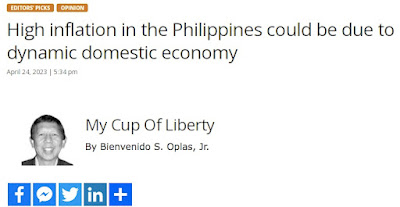* BusinessWorld April 24, 2023.
------------
Based on first quarter (Q1) or January-March 2023 average inflation rate, the Philippines has the highest level of inflation in East Asia at 8.3% while Singapore had the highest jump, from only 0.7% in Q1 2021 to 6.5% in January-February 2023. There is no March data yet as of this writing. In Europe, the UK, Italy and Germany are still worse off (see Table 1).
The main sources of the Philippines’ high inflation in Q1 were alcoholic beverages and tobacco due to the continued rise in sin taxes; food and non-alcoholic beverages due to some supply disruption plus the sugar tax; transport due to still high prices of oil products; and water-electricity-gas-other fuels due to high oil and coal prices until late February. The high inflation in restaurants and accommodation/hotels could be related to “revenge spending” that started in Q4 2022.
The IAC-IMO proposed short-term solutions that include to “fill the domestic supply gap through timely and adequate importation based on ex-ante supply-demand analysis.” Over the medium- to long-term, the IAC wants to ensure “water and energy security.” This is a better goal than ensuring water and energy affordability. The most expensive, the most non-affordable situations for the consumers are no water and no electricity (blackout).
From this policy direction, I constructed this table of charts of selected commodity prices. Row 1 is energy: WTI crude in $/barrel and Coal (Newcastle) in $/ton. Row 2 is industrials: urea fertilizer in $/ton and steel rebar in CNY/ton. Row 3 is agricultural: corn and wheat in $/bushel. Row 4 is also agricultural: rice in $/cwt and sugar in $/lb.
Energy prices are declining — especially coal that fell below $200/ton since around Feb. 27 — so we should expect electricity prices to decline starting April for May billing. Fertilizer and steel bar prices are also declining, meaning lower cost of farming and construction. The price of corn has stabilized while that of wheat (for bread, pasta, noodles, etc.) is at a low 2021 level. Rice and sugar prices are high or rising so their importation can be minimized if domestic output is good (see Table 2).
Looking at the quarterly growth of GDP in 2022, the Philippines has had the most consistent fast growth at 7.2% to 8.2% per quarter, with full year growth of 7.6% which was third fastest growth in East Asia next to Malaysia with 8.8% and Vietnam with 8.1% (they had outlier quarterly growth of 13%-14% and moderate growth of 5%).
Then there is the labor and employment data for February 2023, released by the Philippine Statistics Authority. The data seems good, very good to me. One, the labor force participation rate (LFPR) is high at 66.6% — it was only 63.8% in February 2022 and 63.3% full year 2021. High LFPR means people are optimistic that they can find good paying jobs, or they can employ themselves via entrepreneurship. Two, the unemployment rate is low, only 4.8% vs. 6.4% in February 2022 and 7.8% full year 2021. Three, the underemployment rate is also low, only 12.9% vs. 14.0% in February 2022, and 15.9% in the full year 2021.
So, both quarterly GDP in 2022 and employment data in February suggest that the Philippines now has a dynamic domestic economy that can sustain growth even if the external and global economy would worsen again like what happened in Q1 and Q2 of 2022. Thus, the persistent high inflation could be due mainly to high domestic consumption, and the high interest rates of the Bangko Sentral ng Pilipinas have not dissuaded many people from parking their money in the banks and opting to spend more instead.
If people can create more jobs for themselves, then government — especially the economic team — can step back from creating new subsidies or expanding existing ones, maybe even stop some subsidies and focus on having a fiscal balance, if not a fiscal surplus, without raising existing tax rates.
The economic team should also resist many groups’ “tax-free” lobbies and, if possible, amend some laws that create double standards in taxation. Like zero tax (import tax, excise tax, VAT, etc.) for intermittent renewables but high excise tax and VAT payment for conventional fuel sources like coal that provides baseload 24/7 electricity to people and businesses.
Finally, the National Government should remind local governments that they should be more business-friendly and not bureaucracy-oriented. I hear more and more stories of city and provincial governments making the extractive sectors (like mining, quarrying and landfilling) get more expensive, more bureaucratic. When land prices are rising fast, this means new land should be created via land reclamation in the sea and land filling of less productive fishponds.
Rising land area coupled with a rising population — which means more producers and consumers, more entrepreneurs and workers — should work to our economic advantage.
----------
See also:
BWorld 595, Cancer spending and the budget, April 19, 2023
BWorld 596, More on Meralco distribution charges and energy transition, April 20, 2023
BWorld 597, GDP expansion and an irrational lobby, April 24, 2023.



No comments:
Post a Comment